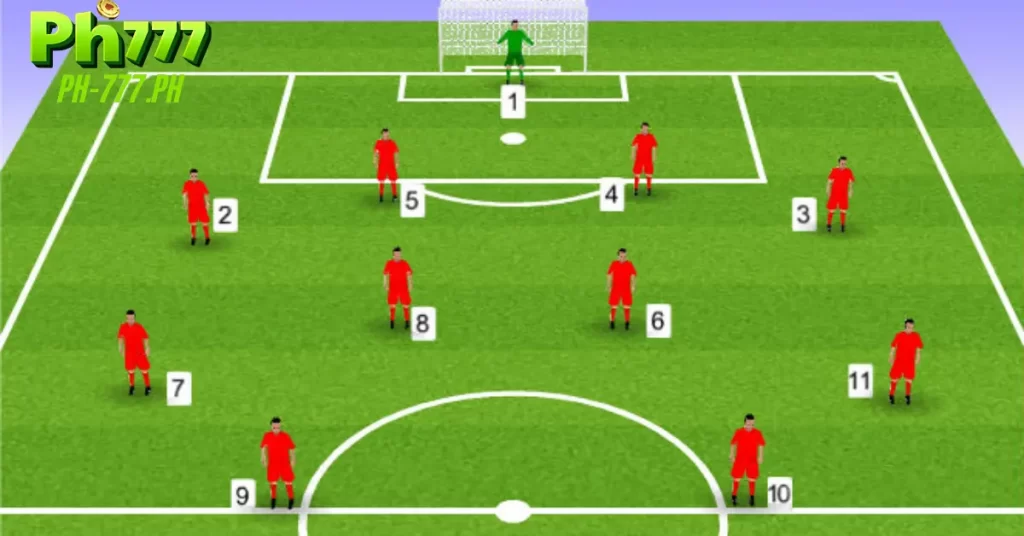Overview 11-Player Soccer Tactical
For all matches played on an 11-player field, a well-planned tactical strategy is essential for an exciting and intense game. It’s clear that the team needs a coach (head coach or manager) who acts as a brilliant strategist, and the players are like brave warriors. Each player assumes a critical role within the team’s strategy, including attackers, defenders, and goalkeepers or in other words, forwards, midfielders, and the goalkeeper.
Let’s explore the 11-player Soccer Tactical with PH777 in this article.
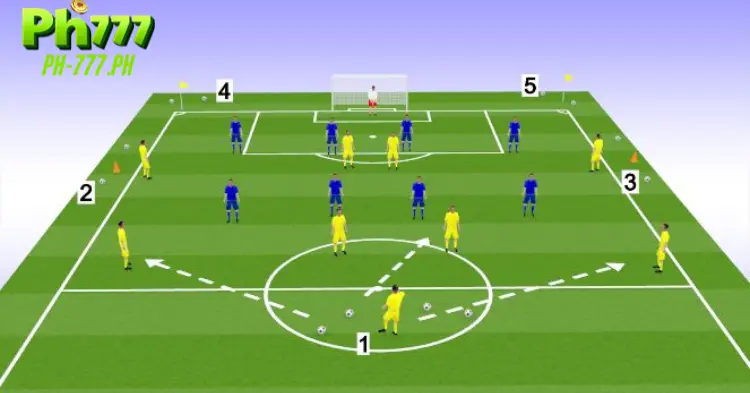
1. 11-Player Soccer Tactical Formation: 4–3–3
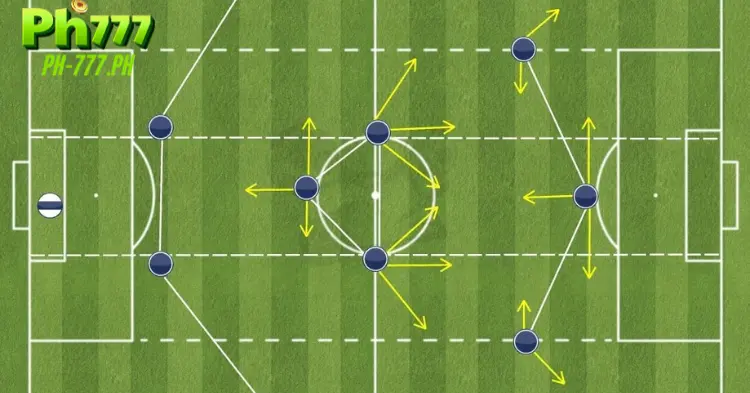
The 4–3–3 formation consists of:
- 1 Goalkeeper
- 4 Defenders (2 full-backs and 2 center-backs)
- 3 Forwards (2 wingers and 1 center forward)
- 3 Midfielders (2 wide midfielders and 1 central midfielder)
The 4–3–3 is one of the most common tactical formations. It’s easy to play, enabling quick transitions between attacking and defending. The three midfielders position themselves close to one another to facilitate support for the defensive line.
Additionally, near the opposing goal, the three forwards spread horizontally across the field, creating significant pressure on the opposition’s defense.
A coach’s decision to use the 4–3–3 at the start of a match can be risky—it may lead to either a convincing victory or a quick defeat, as the formation tends to balance offense and defense equally. However, if the team urgently needs a goal, the coach might deploy additional strikers or push central and wide midfielders higher up the field to break through the opponent’s defensive line.
2. 11-Player Soccer Tactical Formation: 4–2–3–1
The 4–2–3–1 formation consists of:
- 1 Goalkeeper
- 4 Defenders (2 full-backs and 2 center-backs)
- 2 Central Defensive Midfielders
- 3 Attacking Midfielders (1 central attacking midfielder and 2 wide midfielders)
- 1 Striker
In the 4–2–3–1 formation, the two central defensive midfielders focus primarily on defending. The wide midfielders play dual roles, assisting in attack while also contributing to the defensive efforts alongside the central midfielders.
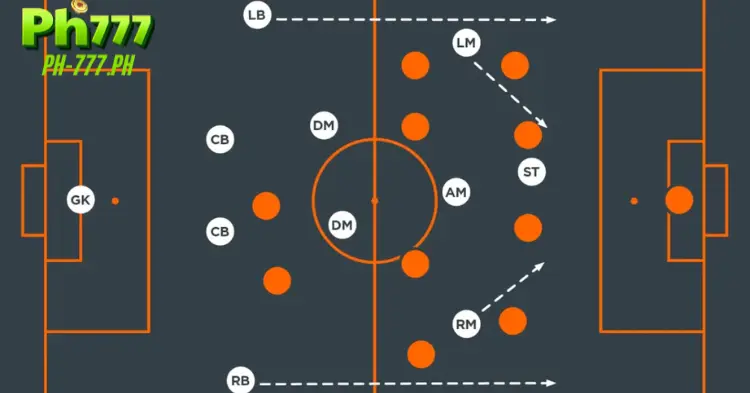
Playmakers hold a pivotal role in this formation. These players must possess the complete skill set of a talented creator while also being capable of scoring like a striker. Their responsibility is to dictate the team’s gameplay. Typically, these playmakers are not assigned fixed positions and are allowed to operate freely on the field.
The 4–2–3–1 was a fundamental formation during the 2010 FIFA World Cup in South Africa. Half of the 32 teams in the tournament employed this strategy.
THE EVOLUTION OF FOOTBALL TACTICS
With the continuous development of football today, tactical strategies in football have also gradually been formed and perfected.
In the early stages, football was played solely to achieve victory. Therefore, players often needed to pay more attention to implementing tactical strategies, and teams were arranged in the simplest formations. When people started focusing on teamwork for greater efficiency, players on the field began to adopt more rational roles, including passing, receiving, attacking, and defending. Gradually, these clear offensive and defensive tactics were developed and perfected. This not only improved the technical skills of players but also enhanced the effectiveness and diversity of tactics employed.
=> Read more: Boost Your Winning Odds When Betting on the English Premier League
The Development of Football Tactics Can Be Divided Into The Following Stages:
Stage 1 (1863–1924): The Formation and Experimentation of Football Tactics
The primary formations during this stage were:
- 9 Forwards and 1 Defender
- 8 Forwards and 2 Defenders
- 7 Forwards and 3 Defenders
- 6 Forwards and 4 Defenders
- Arranged in an “inverted pyramid” structure (wide at the top, narrow at the bottom).
Tactical Characteristics:
Players were positioned in fixed roles with rigid and simplistic tasks. Because the number of attacking and defensive players was so disproportionate, teams faced significant challenges, especially with the offside rule. These formations featured inflexible gameplay and tactics, focusing primarily on straightforward dribbling with little tactical coordination between players.
As football progressed to meet real-world demands, players gradually adopted concepts of offense and defense, moving away from overly mechanical arrangements. These changes led to a more rational and adaptable system compared to ancient times, marking a clear transformation in football during this period.
Stage 2 (1925–1953): The Development and Stabilization of Football Tactics
The primary formation during this stage was the WM Formation.
Tactical Characteristics:
- Clearly defined positions and roles.
- Balanced distribution of offensive and defensive players.
- Equal physical demands on all players.
- The team’s strength was concentrated in the midfield area.
In this formation, defenders did not advance into the opponent’s half, and forwards did not retreat into their own half for defense. However, due to the limited number of players near the penalty areas, it took a lot of work to create pressure or alter positions effectively. Attacks relied heavily on long passes, and defenses had significant gaps, leading to straightforward, powerful shots at the goal. This tactical system was relatively simplistic.
Stage 3 (1954–Present): Creativity, Development, and Refinement in Football Tactics
The primary formations include:
- 4–2–4, 4–3–3, 4–4–2, 3–5–2, 5–3–2, and several variations of these basic formations.
Tactical Characteristics:
- Enhanced strength and coordination in the penalty area.
- Fewer forwards, increased midfielders and defenders, and greater offensive threats from the second and third lines.
- Flexible and diverse formations.
- Highly conducive to implementing comprehensive gameplay.
=> Read more: Expert Tips for Winning Big in the Champions League Betting Season.
Key Factors Driving the Development and Refinement of Tactics
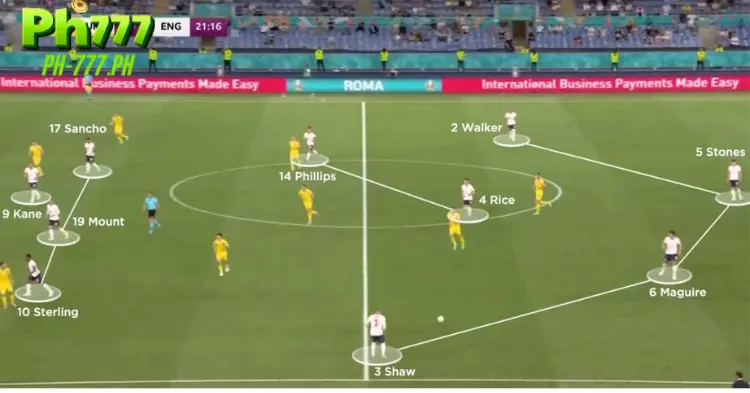
- Revised Methods and Rules:
Changes to laws and playing methods played a significant role. For example, the transition from a 9-forward, 1-defender formation to the WM formation dominated global football due to changes in match regulations. - Improved Skills and Strategies:
As technical proficiency, tactical improvement, and physical fitness levels increased, new formations were required. These new systems prompted the emergence of innovative tactics, which in turn enhanced and refined gameplay. - Innovation for Victory:
To secure victories, teams constantly sought to create new tactical systems. For instance:- In 1872, Scotland used a 6-forward, 4-defender formation to defeat England’s 7-forward, 3-defender setup, highlighting the importance of innovation in formations.
- In 1954, Hungary modified the WM formation to introduce a “4-forward” strategy, defeating England twice.
- In 1958, Brazil employed a 4–2–4 system to counter the 4-forward strategy.
- By 1974, the Netherlands and West Germany introduced a 1–3–3–3 system (1 free defender, 3 defensive midfielders, 3 midfielders, 3 forwards), marking the beginning of “Total Football” (all players attack, all players defend).
- Maximizing Team Strength:
To fully utilize the strengths of both the team and individual players, teams strive to gain dominance by implementing new tactical systems or diversifying old ones. This is a significant driving force behind the development and perfection of football tactics.
=> Are you looking for a reputable and top-quality casino for betting? Try our partners: Phwin.
Summary of 11-Player Soccer Tactical
Arranging and organizing formations are among the fundamental factors that define match strategies. Through analysis and practical research, experts have gradually mastered the principles of tactical setups, enabling the development of more comprehensive and scientific formations.
These innovations are creatively applied in matches to increase the efficiency of both offensive and defensive plays. As a result, the evolution of formations drives the advancement of techniques and tactics, enhancing the level of play and the overall appeal of football.
Final Note:
Now that you’ve learned about several 11-player soccer tactics, why wait? Get your team a new football jersey and hit the field today!

